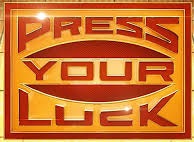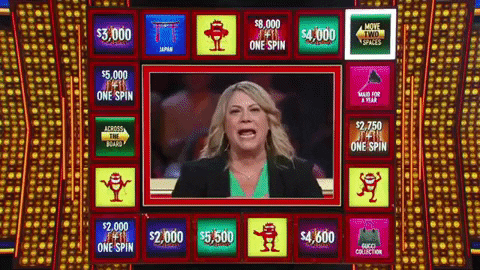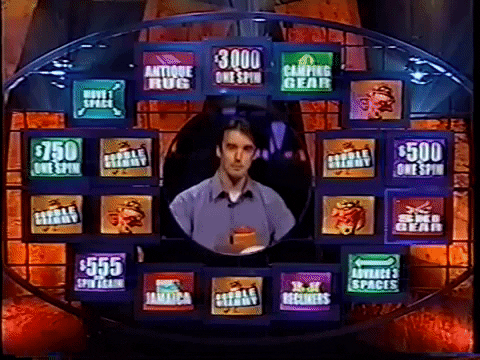Press Your Luck and Pot Roast: Exploiting the Big Board

33 years on from its original cancellation, and 16 years after GSN revived it, Press Your Luck is back on our screens, introducing a new generation to the dreaded Whammy. Watching the premiere episode, I had two reactions. Firstly, of course, I was transported back to my childhood, watching the reruns of the original show during USA Network’s afternoon game show block. I certainly think PYL had a lot to do with fostering both my love for game shows and statistical analysis, so watching a very faithful rendition of it come to life in 2019 hit me with a great big wave of nostalgia, as I’m sure was the intention when they greenlit it.
The second reaction I had was the memory of an old story. I’ve heard this story told in a bunch of different ways, but Google tells me it’s usually called the Story about the Pot Roast:
One day after school a young girl noticed that her mom was cutting off the ends of a pot roast before putting it in the oven to cook for dinner. She had seen her mom do this many times before. When asked why her mom answered “I don’t know. it’s what my mom always did. Why don’t you ask your Grandma? ” Her grandmother, in turn, replied, I don’t know. That’s just the way my mom always cooked it. Why don’t you ask her?
So, undeterred, she called her great-grandmother, who was living in a nursing home and at last got an answer. Great Grandma explained. “When I was first married we had a very small oven, and the pot roast didn’t fit in the oven unless I cut the ends off!”
Why did this old saw come to mind as I watched? Because in their desire to keep the show as close to the original as possible, they managed to retain some of the flaws present in the gameplay of the original show. Flaws that were no doubt caused by the corners the producers had to cut to run the Big Board on the technology of the early 1980’s. Flaws that could have been easily be fixed with the technology of today.
Flaws that somebody could exploit.

Here’s a quick word about the rules of the game, if you need a refresher. The game is dominated by what’s known as the Big Board, a large display of 18 squares, arranged in a rectangular pattern. A flashing light randomly bounces from square to square, while the contents of each square also change in a regular pattern. The player who is in control of the Board may stop the Board’s movement at any time by hitting their button. The contents of the square that the flashing light stops on is what the player adds to their bank. It could be cash, it could be a prize, but it could also be a Whammy. Landing on a Whammy bankrupts the player, so it’s imperative to avoid the Whammy as often as possible.
The main game is played in two rounds, with two different board configurations. In the first round, there are 9 Whammies out of a possible 54 possible slides, which should lead you to a 1-out-of-6 chance of hitting a Whammy. However, two of the Whammies are located in one single space, which very slightly decreases the chances to 16.54%. The board configuration in round two adds a 10th Whammy, and the chances of hitting one of those suckers is 18.37%.
Can we come up with a viable strategy to hit a Whammy less often?

Fans of the game certainly know about the famous Michael Larson exploit, where a contestant on the original show memorized the finite number of paths that the bouncing light could take in order to always land on a space that never contained a Whammy. I have no doubt that the patterns of lights that flash on the Big Board today are as close to random as computationally possible, so trying to replicate Larson’s feat is a fool’s errand.
Instead, I noticed three flaws that they kept from the old show, no doubt to keep the show looking as close to the original as possible. These flaws taken together suggest a couple of strategies that one could use to land on the Whammy significantly less often than a player who is just randomly stopping the board.
Flaw 1: Every space on the board only contains three possible outcomes.
Back in the day, when they used slide projectors to create the Big Board, they had to limit the number of possible outcomes in each square. But nowadays, no such limit exists. They could have increased the potential number of outcomes to a huge number, or even have certain prizes move around the board, showing up in different squares. But, since they chose too keep the three-outcomes-per-square setup, we can quickly and easily enumerate all possible outcomes that a square can hold, and just as easily determine the chances of hitting a Whammy given any board configuration.
Flaw 2: All of the spaces change at the same time.

This was a flaw that was corrected by GSN in their revival, but has since returned. This means that, instead of the board being in a constant state of flux, there exists a small period of time where the board state freezes. If one is quick enough, one could theoretically count the number of Whammies currently present on the board, and in doing so not stop the board unless that number was in your advantage.
One thing we must keep in mind when creating a strategy is that we must stop the board within a reasonable amount of time. If we resolve not to stop the board unless there are zero Whammies showing, then we’re going to be waiting for quite a while, since that only happens on average once every 50 transitions. (For the purposes of this article, when I talk about a “transition”, I’m talking about the time when the spaces change their contents, not when the bouncing light changes squares.) Studio time is expensive, so even though they would edit the down time for broadcast, I’m sure the producers would have a word with if it took you two minutes to stop the board. Considering that, we want to have a strategy that will stop the board within a reasonable number of transitions most of the time. For the purposes of this article, I will define a “reasonable number of transitions” as stopping the board within 10 transitions or fewer 90% of the time.
Playing around with the percentages, I found that a strategy where you stop the board if there are 0 or 1 Whammies showing within the first seven transitions, and stopping after that when 2 or fewer Whammies are showing means that you’ll be hitting the buzzer within 10 transitions 90.7% of the time, and within 14 transitions over 99% of the time, which is good enough for me.
If we follow this strategy, there will be an average of 1.12 Whammies on the board when we hit the buzzer, which translates to a Whammy rate of 6.27%, which means instead of hitting a Whammy once out of about 6 spins, we are now hitting a Whammy once out of about 16 spins!
There is, however, one giant, glaring flaw in this strategy, and that’s those pesky limits of human ability. I took a stopwatch to last night’s episode, and calculated that the time between transitions of the board is about 4/5ths of a second. Thanks to the fact that the Whammies are always in bright yellow squares that stand out compared to all the other squares, it’s not too difficult to count their number within that time just using peripheral vision. However, determining if that number is lower than the threshold, and then send the signal from the brain to the hand to push the button to stop the board within that time is a very tough ask for everyone but the twitchiest of e-sports professionals.
So is there another strategy we can use? Yes, there is, taking advantage of a one more flaw that has been carried over from the old days.
Flaw 3: When a square transitions, it cannot display the same thing twice in a row.
In the past, in order to effect a transition, they had to change the slide that was projected onto a square. But nowadays, they are under no such limitation. If they wanted to, they could keep the displayed outcome of a square the same from transition to transition, but they chose not to.

What does this flaw mean for us? Well, we know that if a Whammy is currently displayed on a square, we know that when that square transitions, the Whammy will go away, leaving something else. Only one square in each of the first two rounds contains multiple Whammies. All of the other squares, if they currently contain a Whammy, are then guaranteed not to hold a Whammy once it transitions. So, if we can count the number of Whammies on currently the board, and that number is higher than average, then we should expect a lower than average number of Whammies to show up the next time the board transitions!
This strategy is much easier to execute. Thanks to the Whammy squares being visually different from the rest of the board, it is certainly possible to count the number of Whammies present within 0.8 seconds, which gives you another 0.8 second window to push the button once you see the board transition. Try this wit the GIFs on this page, or the next time you watch the show, and you’ll see that this seems very doable.
Let’s try to create a strategy using the same limitations as above. If in the first five transitions, you count five or more Whammies, you will want to hit the button after the next transition. Otherwise, hit it the transition after counting four or more Whammies. Following this strategy, you’ll still hit the button within 10 transitions 90% of the time. You’ll also decrease your Whammy rate from 16.54% to 11.46%, which is about 1 in 8.72 spins. The difference is smaller, but still pretty dramatic.
As I mentioned above, the board changes for round two, and adds another Whammy. With the increased odds, we need to create a new strategy following our usual restrictions. Thus, If you count 5 or more Whammies on the board in your first 8 transitions, stop the board on the following transition. After 8 transitions, drop that threshold to 4 Whammies. This strategy will still result in hitting the button within 10 transitions 90% of the time, and drops the Whammy rate from 18.37% to 13.17%, or about 7.6-to-1.
People expecting a Larsonesque strategy might be disappointed, but a person following this strategy will still hit 40% fewer Whammies compared to a person randomly stopping the board. If you’re hitting Whammies 40% less often than your opponents, I like your chances. As people like professional sports bettors or poker players would tell you, small advantages can add up to big wins.
